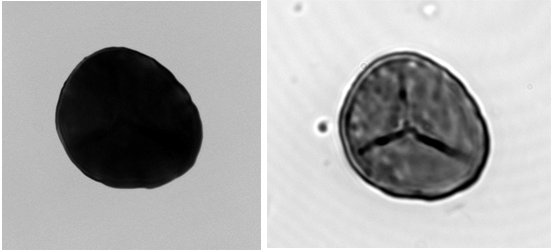
The same specimen photographed in transmitted white light and infared light microscope
A collection of low-grade metamorphosed rocks from Lvchun, Yunnan, Southwest China were found to contain a variety of highly mature microfossils comprising cryptospores, trilete spores, and dispersed plant fragments (tubular structures) as well as a small number of marine palynomorphs (acritarchs and scolecodonts), by Dr. LIU Feng from Nanjing Institute of Geology and palaeontology, Chinese Academy of Sciences and his colleagues. Infrared microscopic examination enabled the recognition and description of 38 species.
Based on its correlation with previously established palynozonations and independent age evidence from acritarchs and graptolites, the palynomorph assemblage from Lvchun is attributed to the early Ludlow age. This new age constraint suggests that at least the upper level of these presumably Llandovery rocks in Lvchun belongs to the early Ludlow age.
The palynomorph assemblage of Lvchun from Indo-China terrane share many taxonomic similarities with coeval findings from Tunisia and Saudi Arabia (i.e., southern Gondwana), hence reflecting the early geographical proximity of the two palaeocontinents. The increasing quantity and diversity of trilete spores point to the rapid evolution of early vascular plants in Indo-China terrane during the early Ludlow.
This work was funded by Strategic Priority Research Program (B) of the Chinese Academy of Sciences and the National Natural Science Foundation of China.
Download:
